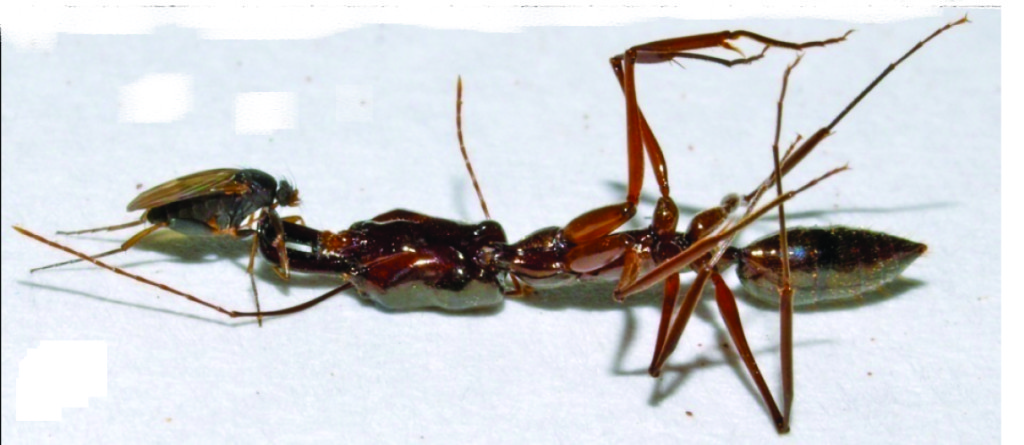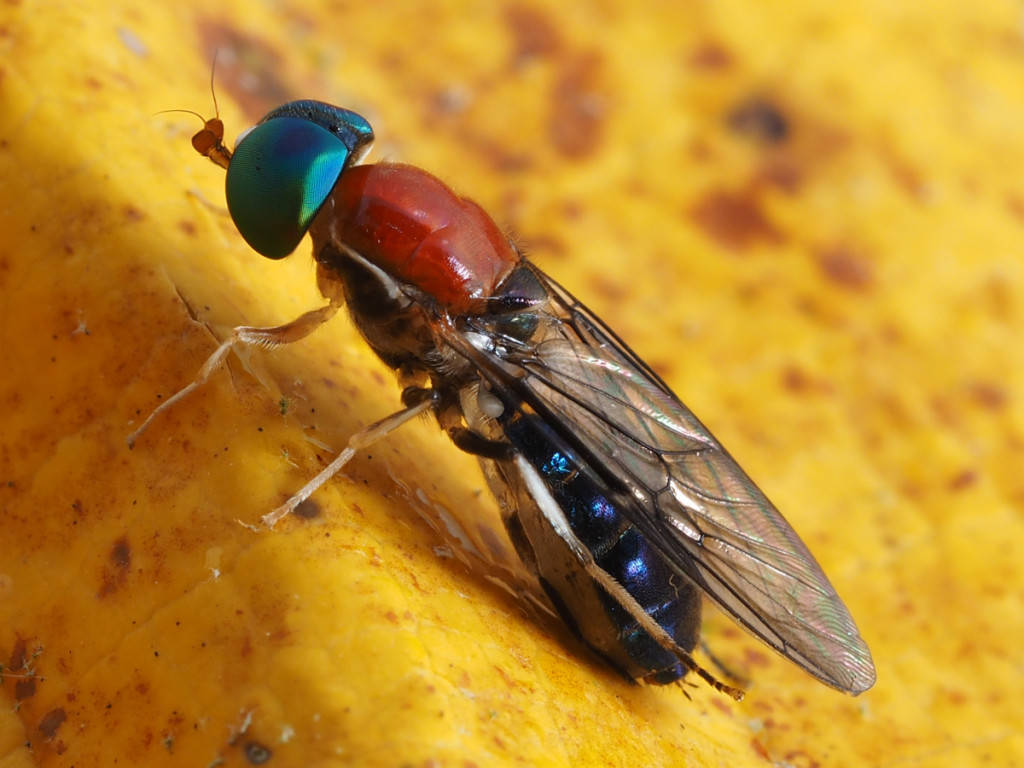Last week Emily Hartop and I published a new paper on the phorid fly fauna of Los Angeles, in the journal Urban Ecosytems (get the full text here). This is the culmination of years of work by all of the BioSCAN team, in getting the project up and running, sorting and identifying 40,000+ flies (mostly Megaselia, mostly the work of Emily), and looking for patterns in the community.

Lisa Gonzalez of the BioSCAN project and Joe Hogg, one of the site hosts, in Joe’s backyard.
The major findings for us is that the Los Angeles urban fauna consists of about 100 species (43 of which were new to science and described by us for the first time), but individual sites (mostly backyards) had from the mid-twenties in the area just west of the museum to 83 species in Glendale, right up against the mountains.
The commonest species by far is Megaselia agarici, a fungus-feeding species possibly introduced from elsewhere. It is sometimes a pest in commercial mushroom farms, but here they are extremely common in “wild” Agaricus mushrooms that we have found in the city and brought indoors for rearing the flies. This species is so prevalent, that it was found in every one of our 30 sites (as were a few other species), and in some sites it made up over 70% of the phorids captured. Many of the other commonest species in the study were also mushroom feeders, such that at least 40% of our collected phorids have this lifestyle.

In contrast, our most diverse site had many more species that do other things, especially those that parasitize ants (including the infamous “ant-decapitating flies” I have written about elsewhere). These ant-associated species are completely absent from the downtown area, almost certainly because the introduced Argentine ants have completely eradicated the other species of ants formerly found here. It is difficult to know how much damage was caused by the introduction of “argies” here, but it was a catastrophe for phorid flies.
Many other results are in the paper, and I urge all interested fly aficionados to read it. The next step will be to associate these diversity data with variables of climate and urbanization to see if we can find some correlations that make sense. We are far from finished working on L.A. phorids! But the outstanding remaining question about this phorid community we have here is whether it is representative of other urban phorid assemblages, here in California, here in North America, and throughout the world. Are all urban sites dominated by fungivores? Do they all have a superdominant species like M. agarici (or maybe even M. agarici itself)? We just don’t have any data to know the answers yet.

Additionally, one of our next studies will be to look at other groups of insects (including other families of flies) to see how they are distributed in the city. I expect that there will be some major differences among groups, attributable to small-scale differences among sites. One study (Avondet et al. 2003) in Ohio, looked at, among other things, the distribution of dumpsters to help predict the diversity of Drosophlia “fruit flies” (Drosophilidae, better referred to as vinegar flies or pomace flies) in the urban landscape! Probably the diversity of plants, flowers, amount of hardscape vs yard, mulch versus grass, and so on will greatly affect the number of species at a site, but our ability to predict this is still in the infancy stage. Stay tuned for more…
Cited article:
J.L. Avondet, R.B. Blair, D.J. Berg, and M.A. Ebbert. 2003. Drosophila (Diptera: Drosophilidae) response to changes in ecological parameters across an urban gradient. Environmental Entomology 32(2): 347- 358.

 In the recent “City Nature Challenge” (an iNaturalist event co-hosted by our museum, LACM), the question was indirectly asked of me “how do you separate the common greenbottle flies, classified in the calliphorid genus Lucilia, from the muscid lookalikes in the genus Neomyia that can also be green.” Especially, how would you tell them apart from the photos in iNaturalist, which are often not of stellar quality. My answer is to look them in the face. In both genera, the distribution of tomentum (microscopic extensions of the fly’s cuticle; not ‘hairs’ or setae, which are socketed) is different. The tomentose parts of the frons reflect light as silver or white, so this is often easy to see in photos.
In the recent “City Nature Challenge” (an iNaturalist event co-hosted by our museum, LACM), the question was indirectly asked of me “how do you separate the common greenbottle flies, classified in the calliphorid genus Lucilia, from the muscid lookalikes in the genus Neomyia that can also be green.” Especially, how would you tell them apart from the photos in iNaturalist, which are often not of stellar quality. My answer is to look them in the face. In both genera, the distribution of tomentum (microscopic extensions of the fly’s cuticle; not ‘hairs’ or setae, which are socketed) is different. The tomentose parts of the frons reflect light as silver or white, so this is often easy to see in photos.





 There is no question that this 1.5 mm long fly is well-named: the male genitalia are a shocking white in comparison to the rest of the rather dingy brown body. It was described in 1910 from England, and is well-known from other parts of the world such as Finland, Israel, and China. It is also found in the two big fly inventories that I am part of: the Los Angeles County Natural History Museum’s urban biodiversity project called “BioSCAN” and the Costa Rican “ZADBI” project in a tropical cloud forest.
There is no question that this 1.5 mm long fly is well-named: the male genitalia are a shocking white in comparison to the rest of the rather dingy brown body. It was described in 1910 from England, and is well-known from other parts of the world such as Finland, Israel, and China. It is also found in the two big fly inventories that I am part of: the Los Angeles County Natural History Museum’s urban biodiversity project called “BioSCAN” and the Costa Rican “ZADBI” project in a tropical cloud forest.


